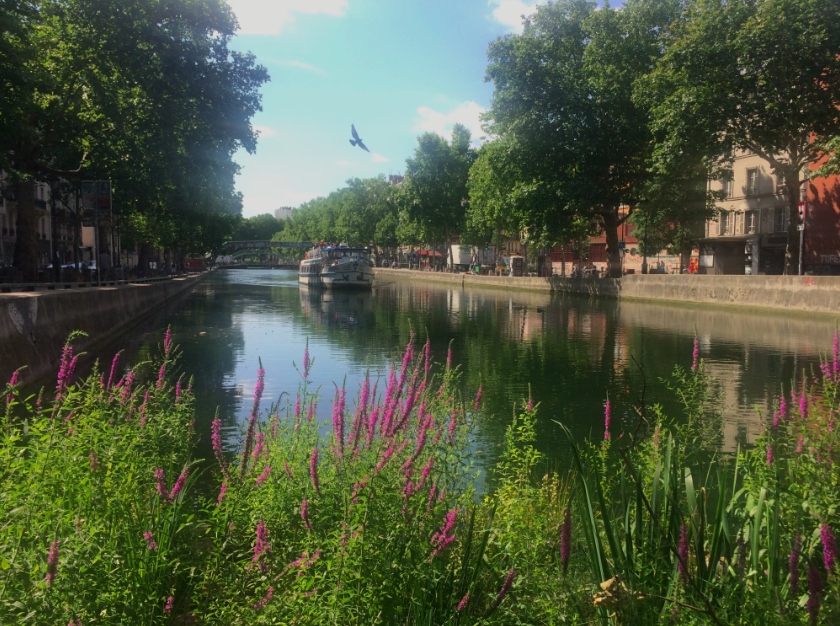A new Paris sustainable floating gardens project is helping to make our capital greener.
Paris is leading the way, with the concept set to spread to other cities around the world.
To find out more we spoke to Katarina Dear, the founder of the innovative ecological startup known as ‘Nature and Us.’
The canals of Paris
While Paris is famous for the Seine river, there are other important waterways that flow through the city. These include the Canal Saint-Martin and the Canal de l'Ourcq.
Created in the 19th century to transport goods and supply water, the canals remain popular with pleasure cruisers, who navigate their system of locks. Day trips on the water also give a different view of the city sights.
But now, the canals are being used to host sustainable floating gardens, alive with plants.
These green rafts aim to fight climate change by reducing CO2, filtering the water, and creating more habitats for wildlife in the city.
Meet Katarina from Nature and Us
A Paris native, Katarina Dear has also lived in the USA, Canada, and Russia. Although her professional background lay in marketing, she has always had a passion for ecological issues.
Her idea for the Paris sustainable floating gardens project was greenlit by the Budget Participatif (Participatory Budget) in 2017 and 2018. This is a scheme that allows Parisians to put forward ideas, choosing how to spend public money to improve their city.
Katarina worked with environmental experts and organizations to bring her idea to life.
Installed in 2019, the first green raft is in the Quai de Jemmapes in the 10th arrondissement (district). A year later, they built a second raft on the Canal de l'Ourcq in the 19th.
Looking like rolls of carpet covered in water irises and rushes, the islands are an intriguing sight for visitors!
The story behind the Paris sustainable floating gardens
56Paris: What is the mission of Nature and Us?
Katarina: We aim to bring back nature within cities. We help urban spaces become more viable, more resilient. To do so, we implement projects which aim to reduce pollution and increase biodiversity.
Our projects are nature-based solutions. Our first is the radeaux végétalisés (floating gardens) in the canals of Paris. These use free space on water to create extra green areas. It has several positive impacts: CO2 reduction, recreating ecosystems, making the canals more enjoyable, and teaching citizens about climate change issues. For each project we implement, we have an educational program linked to it.
We want to transform cities with more positive environmental development and symbiosis with nature.
56Paris: What led you to create the floating gardens?
Katarina: It was the desire to have a concrete action within my hometown of Paris. It started with the floating gardens and transformed into an NGO (non-governmental organization not for profit) which then led to a startup – Nature and Us.
Sustainable development was my passion for a long time, and then became my job!
56Paris: What is the Paris sustainable floating gardens project and how does it work?
Katarina: Our rafts are a type of garden on water. They are floating structures made from recycled and totally recyclable materials. After planting, they’re a zone of refuge for fauna and flora in the middle of a city.
The plant roots dangle underneath the raft, submerged in water and filtering polluting waste. These roots create a natural habitat for fish, and between each vegetated raft there are wooden platforms to create relaxation areas for the inhabitants.
The rafts remain in place all year round and the plants largely regenerate on their own.
56Paris: What are the results to date?
Katarina: In our first floating garden we’ve recorded more than 30 different species! This includes birds, fish, insects, and mammals. Five of these are rare in Paris. The species are using the platform as a place to nest, find food, and rest.
For the moment we are focusing on Paris and its surrounding region, but we are open to opportunities elsewhere and hope to expand in the future.
56Paris: Are there other ‘green’ projects in Paris that you admire?
Katarina: There are many. I would say that I do love all the bike lanes that are being built. I ride to work every day and to see friends, so it’s very important to me.
There is also the biggest urban farm in Europe that opened a couple of years ago at the Porte de Versailles.
56Paris: Where do you think Paris stands in its level of sustainable development compared to other world capitals?
Katarina: Paris is changing, putting a lot of energy into transforming the city on various levels. The way people get around is changing fast, with bike lanes, improved public transport, and creating more green space.
I am also interested in the 15-minute city concept which gives access to everything you need close to where you live.
I love the area where I live in the 18th. It’s a great district as things are continuously changing here, with a variety of cultures and influences.
56Paris: What are your goals for the future?
Katarina: Water is at the center of my perspective on fighting climate change. My long-term goal is to fight climate change by utilizing water surfaces in cities for additional green space, leading to lower CO2 levels.
I believe that change must start with concrete action at the city level, involving every citizen.
Living in a greener Paris
As Paris continues to expand its green credentials, it just adds to our city’s attractiveness as one of the world’s finest places to live and work.
If you are thinking about buying or renting real estate here, the experts at 56Paris are here to help. Contact the team at 56Paris to see how we can assist you.
You can also follow our social media accounts on Facebook, Twitter, Instagram, and Pinterest for the latest news and updates.
Photo: Nature & Us
